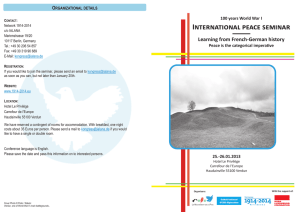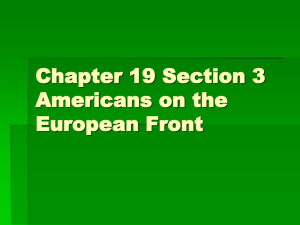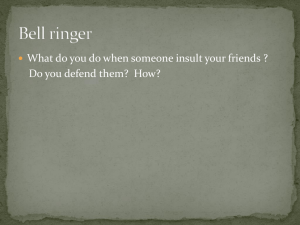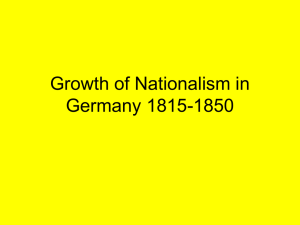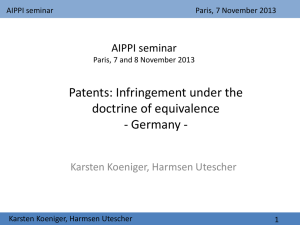3-D trademarks: comparison of national practices in the light
advertisement
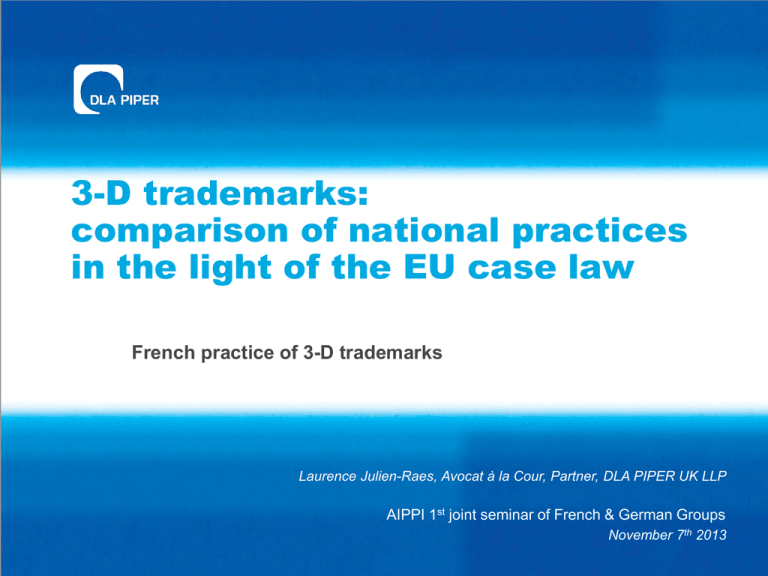
3-D trademarks: comparison of national practices in the light of the EU case law French practice of 3-D trademarks Laurence Julien-Raes, Avocat à la Cour, Partner, DLA PIPER UK LLP AIPPI 1st joint seminar of French & German Groups November 7th 2013 CFI, 28 May 2013, OHIM v Nordic Spirit AB "Voss of Norway" 1. Established EU case law principles: a) The distinctive character must be assessed: i. in relation to the goods or services for which registration of the sign has been applied for ii. in relation to the perception of the relevant public, which consists of the consumers of those goods or services b) the criteria for assessing the distinctive character of three-dimensional marks consisting of the appearance of the product itself are no different from those applicable to other categories of trade mark AIPPI joint seminar of French and German Groups 11/07/2013 2 CFI, 28 May 2013, OHIM v Nordic Spirit AB "Voss of Norway" c) the product shape is not as easily as a verbal or figurative mark recognized by the public as an indication of origin d) it could therefore prove more difficult to establish distinctive character in relation to such a 3-D mark than with respect to a verbal or figurative mark e) only a mark which departs significantly from the norms and customs of the relevant sector is not devoid of any distinctive character AIPPI joint seminar of French and German Groups 11/07/2013 3 CFI, 28 May 2013, OHIM v Nordic Spirit AB "Voss of Norway" 2. Assessment of the distinctive character of 3-D application for a bottle: a) it is well known that the vast majority of bottles available on the market have a cylindrical section. b) the average consumer will naturally expect beverage bottles mostly having that shape. c) The cylindrical bottle, somewhat original, cannot be regarded as departing significantly from the norms and customs of the sector and is therefore devoid of any distinctive character. AIPPI joint seminar of French and German Groups 11/07/2013 4 CFI, 28 May 2013, OHIM v Nordic Spirit AB "Voss of Norway" The severity of the CFI's assessment of the distinctive character appears when it states that: 1) The fact that the Board of Appeal did not establish that there were other similar bottles on the market does not affect the 3-D shape being devoid of any distinctive character. 2) Even if the applicant's bottle is one of a kind, that does not by itself mean that it departs significantly from the norms of the sector and that it therefore has distinctive character. AIPPI joint seminar of French and German Groups 11/07/2013 5 CFI, 28 May 2013, OHIM v Nordic Spirit AB "Voss of Norway" Voss of Norway confirms the more and more severe position of EU case law regarding the assessment of the distinctive character of 3-D trademarks The CFI appears to be especially demanding when it decides whether a mark departs significantly from the norms and customs of the relevant sector The CFI is suggesting that to become a registered trademark a 3-D shape should have acquired a distinctive character through intensive use first AIPPI joint seminar of French and German Groups 11/07/2013 6 Voss of Norway case: a possible impact on 3-D trademarks French practice? Consequences: Same high standards should be applied by the French judges Possible limitation of national protection of 3-D marks to 3-D shape with a distinctive character acquired through intensive use Does the French practice already meet the requirements of the CFI in Voss of Norway with respect to distinctive character? Other points : - substantial value? - infringement proceedings? AIPPI joint seminar of French and German Groups 11/07/2013 7 Distinctive character: differences between EU and French case law? Distinctive character : a strict assessment by EU Courts CFI, 14 December 2011, Louis Vuittton Malletier v OHIM the locking devices used on goods such as trunks, travelling bags, garment bags for travel, handbags etc., may take different forms but very frequently consist of two parts which lock into each other in various ways and of a device, such as a button or lever, to activate the unlocking mechanism. So far as the mark applied for has those characteristics. Therefore this mark consists of the typical image of a locking device for the abovementioned goods and is, therefore, devoid of any distinctive character as regards those goods. AIPPI joint seminar of French and German Groups 11/07/2013 8 Distinctive character: differences between EU and French case law? Distinctive character: a more liberal approach in French case law CA Paris, 20 May 2011, H & M v Louis Vuitton Malletier None of the locking devices submitted by the defendant reproduce or come close to the combined lines of the plaintiff's 3-D mark. Thus, it is likely that consumers will recognize a distinctive character to this shape AIPPI joint seminar of French and German Groups 11/07/2013 9 Distinctive character: differences between EU and French case law? CFI, 22 March 2013, Bottega Venetta v OHIM The shape of this handbag , which is rectangular and have rounded edges, does not depart significantly from the norms and customs of the sector as they result from the applicant's internet search. Therefore, it is no different from the other handbags already on the market and does not indicate an origin = devoid of any distinctive character. AIPPI joint seminar of French and German Groups 11/07/2013 10 Distinctive character: differences between EU and French case law? TGI Paris, 18 January 2013 Bottega Veneta v Paris Heritage The defendant does not provide evidence that this shape results from the nature of the covered goods A handbag may take various forms but the shape of the plaintiff's 3-D mark is specific and departs from the norms and customs of the sector and is therefore distinctive AIPPI joint seminar of French and German Groups 11/07/2013 11 Distinctive character: differences within the French practice? Is the French approach even consistent ? Differences can be identified also within the French case law: CA Paris, 10 April 2013 Gucci v Eram (overruled TGI Paris 13 mars 2012): Defendant does not establish that Gucci horse-bit became common-place in the established norms and customs for shoes. A horse-bit may take many forms without being identical to Gucci's 3-D mark. Therefore, this 3-D mark appears to be distinctive and will be recognized as an indication of origin for shoes by the relevant public. Intensive use of the mark reinforced its distinctive character AIPPI joint seminar of French and German Groups 11/07/2013 12 Distinctive character: differences within the French practice? TGI Paris, 13 March 2012, Gucci v Eram (application of Gucci's 3-D mark made in bad faith – overruled by CA Paris 10 April 2013) + TGI Paris, 17 January 2013, Gucci v Vetir Since the 1960's, horse bits are used on shoes as decorative elements Gucci does not establish that the public will recognize in this shape an indication of the product's origin After this 3-D mark's application, other undertakings continued to use similar horse bits on shoes so that the average consumer of a product of that kind will only see in these signs a decorative element Gucci's 3-D mark did not acquired distinctiveness through intensive use The mark is devoid of any distinctive character and shall be cancelled accordingly AIPPI joint seminar of French and German Groups 11/07/2013 13 Substantial value: differences in France & EU? A difference of wording can be noted between French and EU law: Directive 2008/95/EC of 22 October 2008, art. 3, §1 e) iii) : "The following shall not be registered or, if registered, shall be liable to be declared invalid: […] Signs which consist exclusively of: (iii) the shape which gives substantial value to the goods" Article L. 711-2 c) of French intellectual property code: "The following shall not be of a distinctive nature: […] c) Signs […] which give the product its substantial value" AIPPI joint seminar of French and German Groups 11/07/2013 14 Substantial value: differences in France & EU? Consequences? EU wording seems to give a wider scope to this exclusion According to the directive, to be excluded, the shape should only contribute without necessarily giving its intrinsic/inherent value to the good A strict interpretation of French law in the light of the directive could make the French practice as demanding as the EU case law (e.g. CFI, 6 October 2011, Bang & Olufsen) AIPPI joint seminar of French and German Groups 11/07/2013 15 Substantial value: differences in France & EU? CFI, 6 October 2011, Bang & Olufsen v OHIM "it must be noted that, for the goods at issue, the design is an element which will be very important in the consumer’s choice even if the consumer also takes other characteristics of the goods at issue into account". "The shape for which registration was sought reveals a very specific design and the applicant itself admits[…], that that design is an essential element of its branding and increases the appeal of the product at issue, that is to say, its value". "It is apparent […] from extracts from distributors’ websites and online auction or second-hand websites, that the aesthetic characteristics of that shape are emphasized first and that the shape is perceived as a kind of pure, slender, timeless sculpture for music reproduction, which makes it an important selling point". AIPPI joint seminar of French and German Groups 11/07/2013 16 Substantial value: differences in France & EU? = Possible rejection of 3-D trademarks judged as valid by French case law such as: TGI Paris, 13 January 2011, Christian Dior Couture v Naf Naf This shape cannot be confused with the good itself It can be easily separated from the good and can also be used on various goods of different kinds. Thus, the shape does not give its substantial value to the good Dior's cane work pattern AIPPI joint seminar of French and German Groups 11/07/2013 17 Substantial value: differences in France & EU? TGI Paris, 10 February 2012, Ponnay v Burberry The substantial value of the mark has been acquired through intensive use and advertisement investments Consumers will choose to purchase the goods because of their inherent characteristics, their quality and originality Burberry's tartan pattern AIPPI joint seminar of French and German Groups 11/07/2013 18 Substantial value: differences in France & EU? TGI Paris, 6 July 2012, Seven Towns LTD + Rubik v Forimport The cubic shape of the marks does not give a substantial value to these 3-D puzzles. This shape is one among many others in the sector of 3-D puzzles Rubik's cube puzzles AIPPI joint seminar of French and German Groups 11/07/2013 19 3-D trademarks infringement proceedings France Germany Comparison of national practices AIPPI joint seminar of French and German Groups 11/07/2013 20 3-D trademarks infringement proceedings In Germany : the attacked 3-D shape must be used as a trademark/recognized as an indication of origin the existence of others (distinctive) elements such as words, might hinder the public to consider the shape as an indication of origin assessment of the risk of confusion: only the elements with a character indicating an origin are taken into account. The reproduction of aesthetic features will not be sufficient to establish such a risk Different word elements of the infringing shape are thus often decisive in favour of the defendant (Ritter/Milka : similar shape/dissimilar word elements = colour and typical milka cow ruled out the risk of confusion). AIPPI joint seminar of French and German Groups 11/07/2013 21 3-D trademarks infringement proceedings How the infringement of 3-D trademarks is assessed in France? Infringement of 3-D trademarks is judged only focusing on the comparison of the shapes. French judges do not focus their analysis on whether or not the shape is being used as a trademark or seen as indicating an origin. Risk of confusion is assessed in view of the overall impression and the distinctive and dominant elements of the shapes. AIPPI joint seminar of French and German Groups 11/07/2013 22 CA Paris, 13 September 2002, Perrier v Saint-Martial The word elements on the label of the presuming infringing form don't rule out the risk of confusion as the substantial similarity between the shapes of bottles remains. Perrier's bottle (Valvert water) AIPPI joint seminar of French and German Groups SaintMartial's bottle 11/07/2013 23 CA Paris 19 December 2012, Saray biskuvi v Ferrero According to the defendant, there is no risk of confusion considering that "Vagoon" and "Mc Chokels" indicate the origin of the products and the other features are aesthetical and not used as trademarks Two of the Three of the Plaintiff's 3-D marks AIPPI joint seminar of French and German Groups presumably infringing forms: 11/07/2013 24 CA Paris 19 December 2012, Saray biskuvi v Ferrero Appeal Court: Infringement must be judged on the similarities between the products and not the dissimilarities (established principle in French case law) Defendant's products are reproducing the characteristics of the plaintiff's 3-D marks The word elements (MC CHOKELS, WAGOON) are insignificant differences and are unlikely to rule out the overall visual impression leading to the infringement of the plaintiff's 3-D marks AIPPI joint seminar of French and German Groups 11/07/2013 25 TGI Paris, 6 May 2011, Ferrari v Ak Pa Handels The identity of the products combined with the high similarity between the signs creates a risk of confusion for the average consumer The defendant's products were found infringing Ferrari's 3-D mark but only for the red cars Yellow car toys are not an imitation of Ferrari's 3-D mark as the latter is not registered in this specific colour Ferrari's 3-D mark Defendant's product (no picture available) Transparent tube with red chocolates in it and a red or yellow car toy on its top AIPPI joint seminar of French and German Groups 11/07/2013 26 Discussion: Is there a different position in France and Germany especially on the enforcement of 3-D trademarks? Is this a real or a cosmetic difference? What will be the position of French judges on these questions in the future? Could we have a more comprehensive case law between France and Germany? AIPPI joint seminar of French and German Groups 11/07/2013 27

